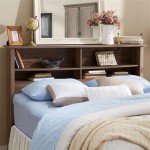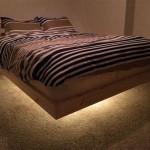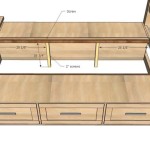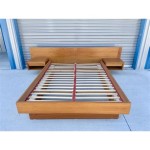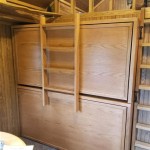Plywood Required for a Queen Size Bed
Building a queen-size bed frame requires careful planning and material estimation, especially when using plywood. This article provides a comprehensive guide to understanding plywood requirements for a standard queen-size bed frame, covering factors like bed dimensions, plywood thickness, and potential design variations.
A standard queen-size mattress measures 60 inches wide and 80 inches long. The bed frame needs to accommodate these dimensions, adding extra space for the mattress to sit comfortably within the frame and potentially accounting for design elements like a headboard and footboard. A common internal frame dimension might be 62 inches wide and 82 inches long, providing a one-inch margin on all sides.
Plywood thickness is crucial for structural integrity and support. While thinner plywood might be tempting for its lower cost, it can lead to sagging and instability. A recommended thickness for a queen-size bed frame is ¾ inch. This thickness provides sufficient strength to support the weight of the mattress, occupants, and bedding without excessive flexing. Using thicker plywood, like 1 inch, is also an option for added durability, though it increases the overall cost and weight of the frame.
The amount of plywood needed depends on the frame design. A simple platform bed requires less plywood than a bed with a headboard, footboard, and side rails. For a basic platform bed, two sheets of ¾ inch plywood cut to the internal frame dimensions (62 inches x 82 inches) are usually sufficient. This provides a solid base for the mattress and adequate support.
More complex designs incorporate additional components. Side rails, typically constructed from 2x4 or 2x6 lumber, provide a perimeter frame. These rails are then attached to the plywood base. The amount of plywood required remains largely the same, though additional smaller pieces may be necessary for supporting center beams or creating a recessed area for the mattress to sit within the frame.
Headboards and footboards introduce further design considerations. These elements can be simple or ornate, depending on personal preference. Plywood can be used to construct these features, adding to the overall material requirements. The dimensions of the headboard and footboard will dictate the amount of plywood needed. For example, a headboard measuring 62 inches wide and 30 inches high would require a piece of plywood at least those dimensions.
Support systems influence plywood usage. Some designs utilize a central support beam running the length of the bed, resting on supporting legs. This beam adds to the structural integrity and reduces the load on the plywood base. Plywood might be used to create a box-like structure for this central beam, adding to the overall plywood requirements.
Storage considerations can also impact plywood usage. Under-bed storage drawers or compartments, often built using plywood, require additional material. The size and number of these storage units will dictate the additional plywood needed.
Beyond the primary plywood components, smaller plywood pieces might be required for various purposes. These include reinforcing joints, creating decorative elements, or constructing supporting blocks for specific design features. It is advisable to purchase slightly more plywood than initially calculated to account for these potential needs and to allow for cutting errors.
When calculating plywood requirements, it is essential to account for the kerf, which is the width of the saw blade cut. This small amount of material is lost with each cut and can add up over multiple cuts, potentially leading to material shortages. Factoring in the kerf ensures sufficient material for the project.
Choosing the right type of plywood is also essential. For a bed frame, construction-grade plywood is generally suitable. Higher grades, like cabinet-grade plywood, are smoother and have fewer voids, but they come at a higher cost and are not typically necessary for a bed frame that will be largely hidden by the mattress and bedding.
Before purchasing plywood, carefully measure all components and double-check calculations. Drawing a detailed diagram of the bed frame with accurate dimensions can help visualize the project and ensure all necessary plywood pieces are accounted for. This pre-planning stage can prevent costly mistakes and wasted material.
Various online calculators and resources can assist in estimating plywood requirements. These tools can simplify the process, especially for complex designs. Consulting with experienced woodworkers or seeking advice from hardware store staff can also provide valuable insights and help optimize plywood usage.
Construction methods can impact plywood requirements. Using pocket hole joinery, for instance, can reduce the need for large overlapping pieces and potentially save on material. Different construction techniques offer varying levels of strength, stability, and material efficiency. Understanding these differences can help optimize plywood usage and achieve the desired structural integrity.

How To Choose Plywood For Bed Frames
How Thick Of Plywood Should I Use Under My Queen Size Mattress Have A Foam And Metal Frame That Doesn T Require Box Spring The Platform Is Made

Plywood For Bed Building Your Own Dream Centuryply

Adona Adonica Fusion Queen Bed Plywood Mauritian Bamboo Light Orange Woods

Brown Queen Size Plywood Bed For Hotel

Box Engineered Wood Plywood Queen Storage Bed For Home
How Thick Of Plywood Should I Use Under My Queen Size Mattress Have A Foam And Metal Frame That Doesn T Require Box Spring The Platform Is Made

Plywood Queen Size Bed With Storage

Queen Size Plywood Bed With Adjustable Headboard Deluxe Wood Platform Frame Slat Support Compatible All Mattress Types No Box Spring Needed Easy Assembly Brown Com

Bed Slats Vs Plywood Which Is Best For Your Frame
Related Posts
